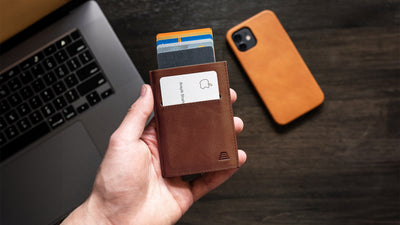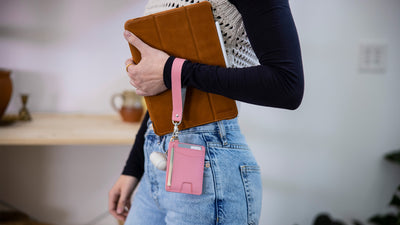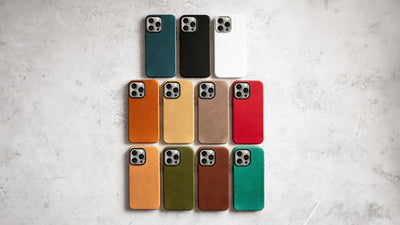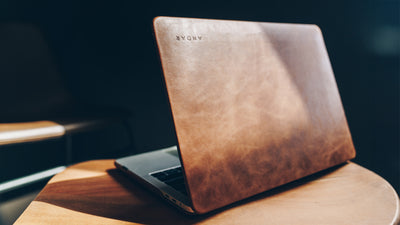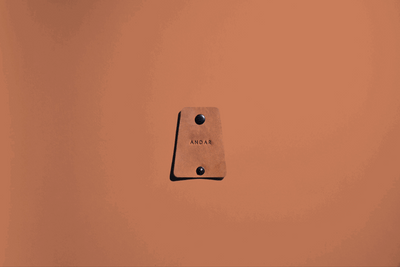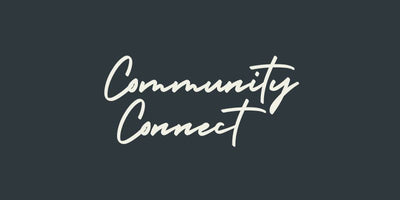The Blog
Full Grain Leather: What Is It and Why Do We Use It?
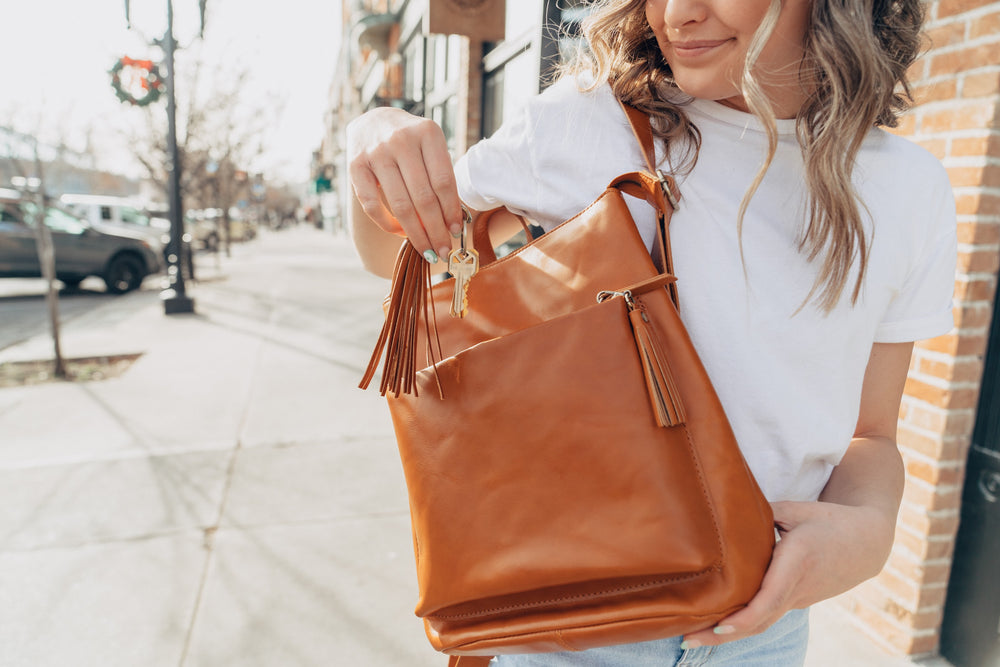
Like any industry, leather has undergone many different iterations and transformations over its lifetime. In the beginning, the tanning of cowhides was done in the sun, and the chemicals used to lock in moisture and coat the skins were mostly made from animal fats.
However, with each advancement in technology, there have been new types of leather or quicker ways to create the same product. This happened first in the 1500s in Italy when Italian leather makers discovered that vegetable products were best for creating long-lasting and beautiful leather. It happened again a few hundred years later when the advent of plastics gave birth to PU leather.
With each new technology and new product or process development, something is gained, and something is lost. Whether this is for good or bad is for the user to decide, as each development was made by some sort of demand for a new way of doing things. Technological advancement is not inherently moral or immoral.
However, we at Andar want to tap into a long history and harness newer processes to create products that harken back to a time when leather was a craft more than a product. We identify ourselves as part of the lineage of the vegetable-tanning of north-central Italy. We have planted our flag in the curation, creation, and perfection of full-grain leather.
So, your question might be: what is it and why do you prefer it? Well, sit back and relax as we break down the process, advantages, and beauty that is the creation of full-grain leather products.
The Process
Like with any textile, the process consists of sourcing, manufacturing, and end product. Here we break down a bit on sourcing, how we cut and tan the leather, then what we can do with the tanned leather afterward.
Transparency and showcasing our care and attention to detail to each piece of Andar product is important to us. All of our products pass a strict quality and control standard, enforced by people whose leatherwork isn’t just a job but a lifelong passion.
Sourcing
In general, there are two ways to source cowhide when making full-grain leather. One way is to harvest the hide for cows designated for meat. The other way involves raising cattle for the exclusive purpose of producing cowhide. Both have benefits, though one benefit is hard to trace and is a bit marginal.
Sourcing by taking the skins of meat industry cows from the meat industry could be a path for a more sustainable leather making process. Hides from cattle raised in the United States generally fetch higher prices than those raised in other places.
In 2013, the United States yielded 1.12 million metric tons of (mostly cattle) hides. This was a .03 increase from a decade prior, in 2003. Additionally, cattle that are grass-raised tend to produce hides that are considered to be an elite product.
According to the US Hide, Skin and Leather Association (USHSLA), there are over 26,000 leather workers in the United States. This number is expected to grow as demand for beautiful leather products increases.
Different sections of leather are set aside for certain products. Large, intact portions of cowhide are needed to create real full-grain leather. Because of this, each piece of full-grain leather is unique. Unlike PU or vegan leather, every inch of full grain leather is truly a one-of-a-kind item.
The Splitting and Tanning Processes
In this part of the tanning process, the cowhide will be split into two major categories: corium and grain. Just like one would assume, full-grain leather comes from the grain part of the cowhide. This is the very top layer of the cowhide.
It may seem better to have parts that are from deeper layers of the cowhide, but this is not quite the case. In reality, you want to get the part that has been exposed to the most weather and other natural elements because the cowhide on top is tougher and more supple, thus making a stronger and more stunning leather.
The corium gets split from the grain through a machine called “the splitter” (indeed, creative). It then gets turned into genuine leather, suede, and split leather. These are lower quality but also have a few good uses, as will be discussed later.
With the grain now separated, it must be decided whether it will be turned into full-grain or top-grain leather. There are a few major differences between these two.
It is important to understand the difference: top-grain leather has a smoothing and dying process that makes it more uniform and less porous, whereas full-grain is more natural and keeps the natural blemishes in.
Both types go through tanning through soaking in vegetable oils, then tanned in sunlight, and sealed with a mixture of salt and other preservatives. Generally, wax is used to polish and finish the cowhide to make it full-grain leather.
This is where the true artistry of tanning leather comes in. Many leather makers spend years in this area trying to hone their craft. Obviously, the tanning of the leather is one of the more difficult processes. It takes great care to craft a full grain leather piece.
Full-Grain Advantages
We at Andar believe that full grain leather is not only the highest value but is the most versatile and best value for leather items that will last a lifetime.
Read on as we break down a few of the biggest advantages that full-grain leather offers:
Full-Grain Leather Is Versatile
We have made countless items, all from full grain leather. You can look at our line of wallets, bags, and cases that all showcase how we can use full-grain leather to support all of your adventures. Full grain leather is incredibly versatile and can be formed (quite literally) to meet any one of your needs or favorite fashion trends.
In contrast, because it is neither supple nor breathable, genuine leather and faux leather is very limited as to what it can be made into. Instead, it is generally used as a varnish over the top of another material like vinyl or cloth and thus is subject to peeling off or otherwise be disposed of due to flimsy construction. This increases leather in landfills and general waste.
Items That Are Made To Last
On top of that, full grain leathers last much longer than other types of leather by a significant margin.
In some estimates, genuine leather and PU or faux leathers can last around three to 10 years, whereas full-grain can last over a full lifetime. This means buying the items is not only good for you as you will not need to invest in a wallet again, but it is also good for the environment in general.
There have been estimates that do not look promising about the fast-fashion version of genuine leather over the next few years. Not only does the leather industry employ thousands of people, but full grain leather is also a more sustainable option.
Development of Patina
Because it lasts longer and because of the cowhide grain that is inherent to its constitution, full-grain leather develops what the industry and fans of leather call a “patina.”
A patina is the term for the natural marks, scratches, and wearing that grain leather undergoes. It is a mark of quality and showcases the craftsmanship of its construction and the care that you have given your item over the course of years. Taking care of leather is simple but worthwhile, so your pieces always look as beautiful as when you got them, with a little extra character thrown in.
Genuine leather has no chance of developing the coveted patina look, nor does any sort of artificial leather. It is reserved only for the highest grade of full-grain leather. So, not only is full-grain leather more sustainable, it has an aesthetic edge as well.
Full-Grain Scratches Almost Every Consumer Itch
Full-grain leather is an investment for its sustainability, durability, and aesthetic chops; it is clear that it’s actually one of the more economical choices you can make.
We have believed in its viability for most leather needs for years and have worked hard to prove its worth with our lines of stylish wallets, bags, and cases, all made with full-grain, oil-waxed leather.
After you first slip your Andar leather out of the package, you can never go back again. Discover your new favorite leather product at Andar that can add a rugged sophistication to everything you do.
Sources:
